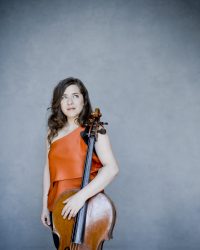 Switzerland Britten, Shostakovich: Alisa Weilerstein (cello), Tonhalle Orchestra Zurich / Joshua Weilerstein (conductor), Tonhalle Maag, Zurich, 6.12.2019. (JR)
Switzerland Britten, Shostakovich: Alisa Weilerstein (cello), Tonhalle Orchestra Zurich / Joshua Weilerstein (conductor), Tonhalle Maag, Zurich, 6.12.2019. (JR)

Britten – Symphony for Cello and Orchestra Op.68
Shostakovich – Symphony No.11 The Year 1905 Op.103
Young American conductor Joshua Weilerstein chose a challenging and uncompromisingly bleak programme for this concert, incongruously juxtaposed with the festive lights of Zurich’s nearby Christmas markets. Britten’s Symphony for Cello and Orchestra is, for the most part, a bleak work, with only a fleeting ray of sunshine at the very end. That explains why it is a fairly rare event on the concert stage, at least outside Britain. Britten was a close friend of Mstislaw Rostropovich, and it was the great cellist who asked his friend to write him this symphony in 1962. Apparently, when Rostropovich first played it through, tears came to his eyes. (Alisa Weilerstein – Joshua’s older sister – told me at the interval that she got ‘goose bumps when the sun rises’ in the final Passacaglia). On first hearing, the listener will probably be baffled by the work’s complexity and the dismal nature of the first movement. It is one of those many works that bear study and repeated listening before the fog may lift. Most concertgoers do not have that fortune; it is well outside their comfort zone. This is difficult Britten, with only passing references in the woodwind to his usual sound world as heard in, say, Peter Grimes. As the composer told the boys’ choir rehearsing the War Requiem back in 1963, ‘this is modern music, boys, you’re not supposed to like it’. (I was one of those boys.)
Alisa Weilerstein played with audible and visible passion and got into the heart and soul of the work. Her cadenza was most moving and skilfully executed; the audience was rapt. I hope she records it some day. I also hope she returns to Zurich with more palatable fare next time, perhaps the Elgar.
Shostakovich’s Eleventh Symphony is not a laugh-a-minute either, but a chilling work. Weilerstein grabbed a microphone and introduced the work to the audience in a short speech, common in the US, but not in Europe; he gave us details of the melodies from revolutionary songs that Shostakovich employed. The work is, as many other of the composer’s works, a protest without words. ‘It is my duty to speak for the people’ said the composer. There is emotional truth telling through the music for which words would be have been too dangerous at the time (and even today). Shostakovich takes as his theme for this work the uprising on ‘Bloody Sunday’ in January 1905. Tsar Nicolas II ordered his troops to shoot at protesters in the huge square outside the Winter Palace in St. Petersburg; many were killed. However, Shostakovich was also clearly making reference to the Soviet repressors of his day; those who sent tanks to Hungary in 1956 to bring down the Hungarian rebellion in brutal fashion. The symphony was composed in 1956 and first performed in Moscow in 1957.
The opening movement ‘The square in front of the palace’ depicts the scene, ominous timpani prophesying that something malevolent is about to happen. The whole movement is pianissimo, fragments of melody in the horns, eerie trumpets, growling trombones. It is the calm before the storm. Joshua Weilerstein was in full command; I would have preferred the movement quieter still.
Then, in the second movement, comes the onslaught. Scurrying strings point to protesters, fearing for their lives, running from the approaching soldiers; blaring brass, side drum, strident strings, jabbing double basses, bugles (muted trumpets) and cymbal crashes signify the gun shots and then Shostakovich does a sudden cut, to almost complete and chilling silence. One can almost see the bloodied corpses in the snow. Weilerstein did not hold back and the Tonhalle’s temporary home was perhaps a mite too small for the level of decibels that Weilerstein unleashed. It was thrilling anyhow.
The third movement is ‘In memoriam’, the survivors’ lament, a Funeral March, suitably sombre in tone before the final movement brings us false triumphalism, superficially victorious, with typical Shostakovich irony. Four huge church bells gave the movement true Russian flavour. (In some performances tubular bells have to be substituted for the real thing, without the same realistic effect). The Tonhalle is fortunate to have these giant bells in its armoury. Weilerstein allowed the final bell to resound well after the music had ended – a nice touch.
The orchestra was in very good form, with particularly fine contributions from the viola section in the symphony, Martin Frutiger on cor anglais, timpanist Christian Hartmann and trumpeter Philippe Litzler.
The Weilersteins are clearly a musical family. Donald, father of the Weilersteins, is a well-known violinist in Cleveland (founder of the Cleveland Quartet), and their mother is the active pianist Vivian Hornik Weilerstein. Joshua, still in his early thirties, has recently renewed his position as Artistic Director of the Lausanne Chamber Orchestra, but he is also known in Britain, having conducted the Royal Liverpool Philharmonic and London Philharmonic. This season he will give his debuts with the BBC National Orchestra of Wales and Chamber Orchestra of Europe. He is clearly a rising star; an intelligent, highly musical young man with charisma. I hope we see more of him in Zurich in seasons to come – perhaps with more Shostakovich.
Alisa Weilerstein has performed with major orchestras such as the NHK and London Symphony and regularly plays with pianist Inon Barnatan, with forthcoming concerts highlighting the complete Beethoven Cello Sonatas. Try to catch one of her next concerts: in a few days with Bach in Barcelona, then the Elgar Cello Concerto with the LSO (December 19th), in Frankfurt in January with contemporary music or in February in Tokyo with husband, conductor Rafael Payare.
John Rhodes
